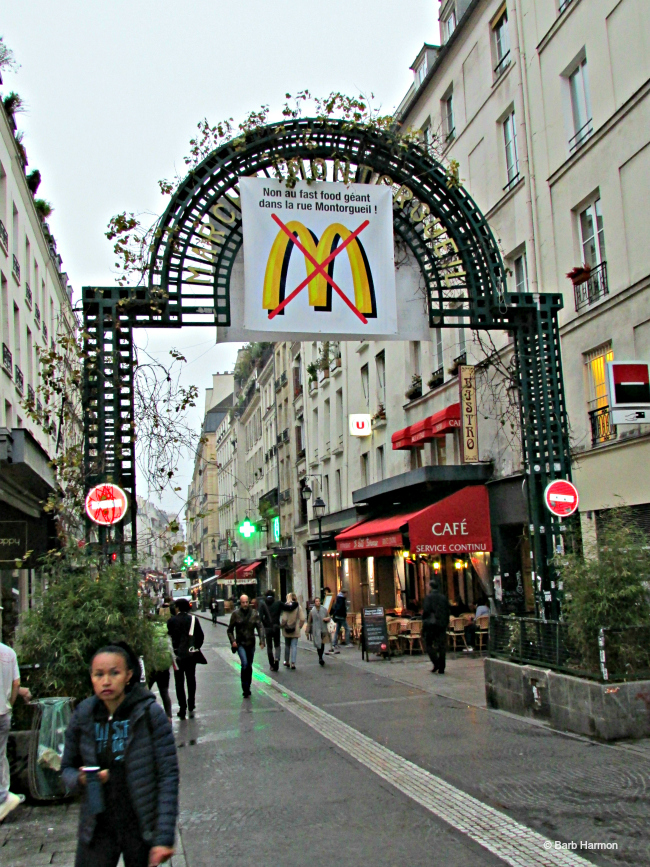
The green arch at rue Montorgueil
The email said to meet where rue des Petits Carreaux and rue Réaumur cross…under the green arch…9:30 am sharp…rain or shine. Upon arrival, a young man approaches and introduces himself as Romain, my guide for the food tour of rue Montorgueil. To be honest, I love to eat and always appreciate a good meal but I don’t consider myself a ‘real foodie’. When I share this, he replied, “This is perfect for you. French people love to eat good food but don’t use the term ‘foodie’. We enjoy food, it is a privilege to eat well.” I feel much better as we begin to walk down the street.
I am familiar with rue Montorgueil from visits over the years. It’s a lively, pedestrian street, and one of my favorites. It’s like a french postcard come to life…café terraces are beginning to fill with folks enjoying a café crème, locals with their shopping baskets already spilling over, duck in and out of the shops.
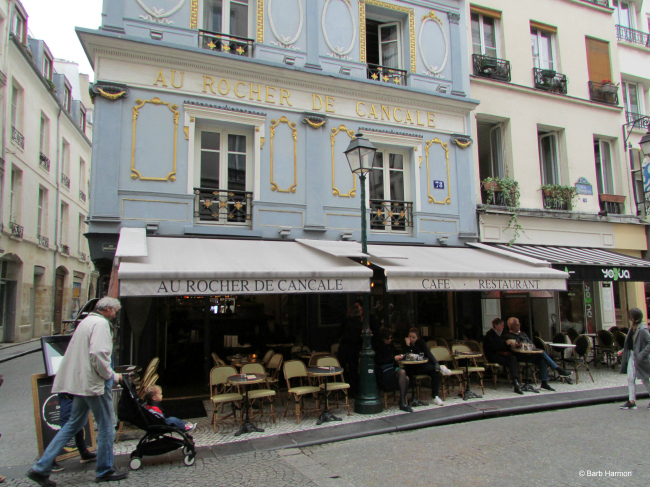
78 rue Montorgueil. One of the most photographed restaurants.
I’m anxious to learn about the area called the ‘belly of Paris’ and of course to sample some of the wares found in the many food shops.
Rue Montorgueil and Les Halles—a blended history
Rue Montorgueil and Les Halles have a long history. There has been a market in this area for over 800 years. In the 1850’s, iron and glass buildings were erected to house the Les Halles markets where they remained until 1971. My guide states, “The markets of Les Halles are gone but its essence remains and lives on through Rue Montorgueil. It is a food lover’s paradise…you can find everything here and as you can see, it’s quite charming.”
Boulangerie for the sacred baguette
A loaf of French bread or baguette as it’s called, has been a symbol of France for decades. My guide Romain states, “The baguette is so important to the French that a decree was put into place in 1993 for the regulation of the baguette de tradition française. By law there can only be four ingredients—flour, yeast, water, and salt. It must be baked on the premises. The crust is even, the holes are of different size, and it is more elastic. It should weigh 250 grams or 8.75 ounces.” Handing one to me, he asks me to ‘break off the end.’ As I struggle, he instructs me to use the heel of my hand. I break it off easily. I’ve learned the proper way to break a baguette—I’m feeling French. I’m reminded to never cut bread with a knife…it’s considered bad luck.
Fromagerie— A cheese for every day of the year and then some
Walking into the Fromagerie, I am reminded of something Charles De Gaulle once said, “How can anyone govern a nation that has two hundred and forty-six different kinds of cheese?” I am told, “the number has almost doubled and if you are to consider the varieties within each cheese, you could be looking at a thousand or so.” I have never met a cheese I didn’t like so I find this thrilling.
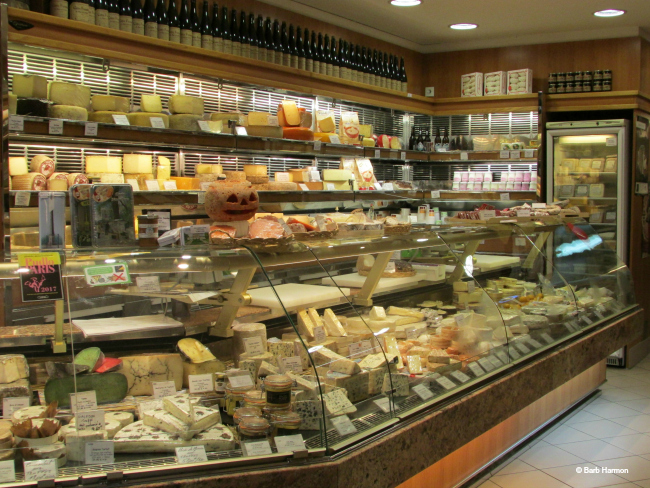
The fromagerie
Three types—goat, sheep, and cow cheese
Before sampling a selection of cheese, Romain explains, “The smaller the cheese, the smaller the animal…there is less milk. At least 56 cheeses are classified, protected, and regulated under French law. We will work our way from goat cheese up to cheese made from cow’s milk.”
We begin with Rocamadour, a small round cheese from southwest France. Made from unpasteurized goat milk…it’s creamy and delicious. I could eat the entire round. My guide states, “The cheese is named after the village of Rocamadour. It is regulated…the milk must come from within 50km of the village…and must be delivered within 48 hours of collection. It has to be precise.”

A cheese a day…and then some.
I’ve always enjoyed Roquefort…tangy, crumbly, and visually appealing with its blue veins but I don’t know anything about this delicious cheese. My guide states, “Roquefort is a protected name. The milk comes from one breed of sheep—Lacaune. It is a very popular cheese in France.”
Our last cheese is Comté which is made from unpasteurized cow milk. Handing me a slice, my guide said, “This is France’s number one selling cheese. Like the others it is regulated.” This is quite different from the other cheeses we have sampled— the texture is dense, the taste is nutty but it is delicious. I understand why it is so popular.
Charcuterie—It’s all about the meat
As we walk into the Boucherie, my guide says, “It’s time to try some charcuterie. He shares, “Every part of the animal is used. Nothing goes to waste. If you can’t see it, it would be in a pâté or terrine.” We start with saucissan, a dried meat I’ve always enjoyed. We try several types…with herbs…garlic…all delicious.
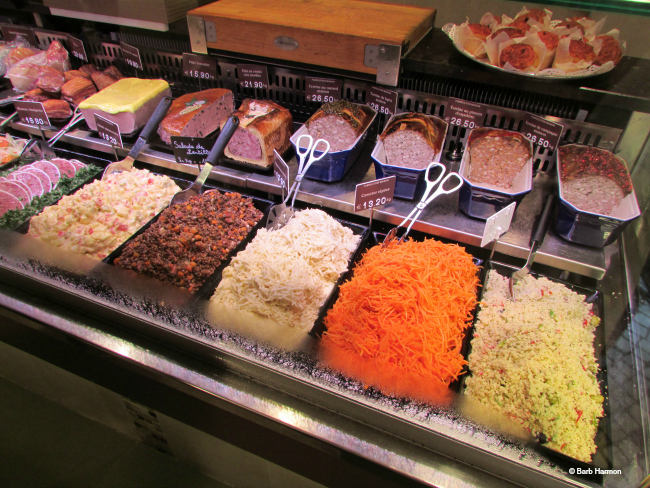
Where to start…
We move on to Rillettes which looks like tunafish. I try it on a piece of baguette before learning what it is. Full of flavor, I find out it is made from pork. The breast and shoulders are slowly cooked, the fat is blended in. The texture is so fine, it’s like a spread. This is best eaten with a cornichon, the delicate french pickle.
Pâtisserie Stohrer—the favorite shop of King Louis XV
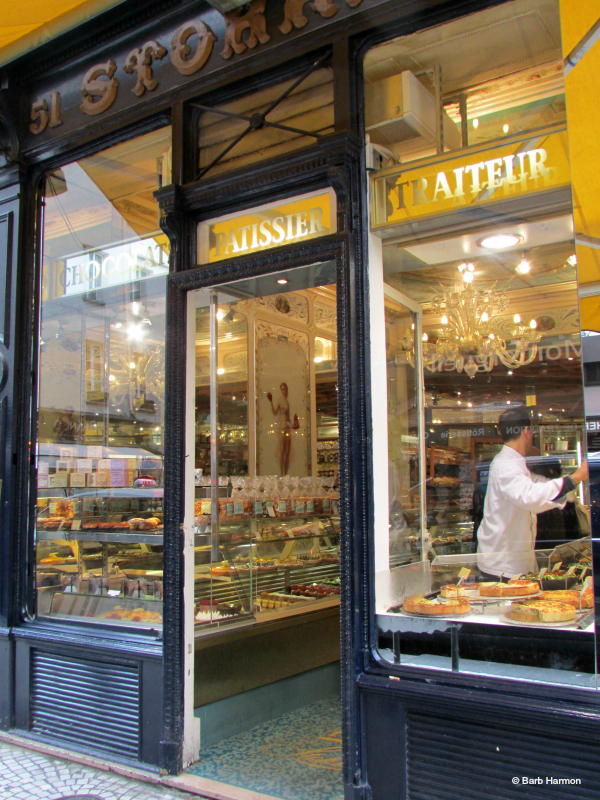
Pâtisserie Stohrer
We end our tour at the legendary Stohrer, the oldest Pâtisserie in Paris. Nicolas Stohrer the Pâtissier at Versailles, opened it in 1730. The shop is magnificent, the display cases…mouth watering. I can see why this was the King’s favorite. Baba au rhum, éclairs, so many choices. We decide on éclairs which are found in a variety of flavors. We choose chocolate and pistachio. My guide said, “The éclair to the French people is like the cupcake to the Americans. It is well loved.”
The iconic éclair
Dessert was a delicious way to end the tour—two hours had flown by. I’m left with knowledge that will serve me well.
Author Scott Westerfeld said, “The best way to know a city is to eat it.” After sampling the delicacies on Rue Montorgueil, I have to agree.
Disclaimer: I was the guest of Discover Walks Paris Food Tour. All opinions, as usual, are entirely my own.
Price: Adults €60, Children 17 and younger €50. Discover Walks has a variety of tours, many are free—gratuity only.
